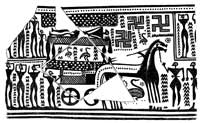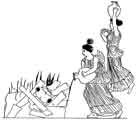.
I am not afraid of being dead, I just do not want to die.
Epicharmus of Cos

Death of Sarpedon (a Trojan ally, leader of the Lycians and son of Zeus, killed by the spear of Patroklos). Hermes Psychopompos (psyche = soul, pompe = escort, procession , "who escorts the souls") in the Middle with the twin brothers Thanatos and Hypnos (Death and Sleep) moving (Sarpedon) to Hades the world of the dead. Calyx-krater, ca. 515 B.C.; Archaic; red-figure, Metropolitan Museum of Art. Signed by Euxitheos, as potter; Signed by Euphronios, as painter, Greek, Attic Purchase, Bequest of Joseph H. Durkee, Gift of Darius Ogden Mills and Gift of C. Ruxton Love, by exchange, 1972 (1972.11.10)
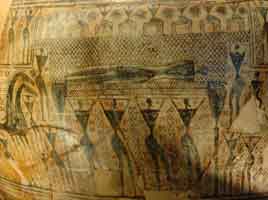
Prothesis of the deceased, Dipylon Painter, c. 750 BC, Louvre.
Prothesis: laying out of the dead body and preparing it for burial
See Burial Rites
From a Gutenberg Text File A Day in Old Athens, William Stearns Davis, Professor of Ancient History in the University of Minnesota:
Chapter XI. The Funerals.
69. An Athenian's Will.--All Menon's patient's are to-day set out upon the road to recovery. Hipponax, his rival, has been less fortunate. A wealthy and elderly patient, Lycophron, died the day before yesterday. As the latter felt his end approaching, he did what most Athenians may put off until close to the inevitable hour--he made his will, and called in his friends to witness it; and one must hope there can be no doubt about the validity, the signets attached, etc., for otherwise the heirs may find themselves in a pretty lawsuit.
The will begins in this fashion: "The Testament of Lyophron the Marathonian.[*] May all be well:--but if I do not recover from this sickness, thus do I bestow my estate." Then in perfectly cold-blooded fashion he proceeds to give his young wife and the guardianship of his infant daughter to Stobiades, a bachelor friend who will probably marry the widow within two months or less of the funeral. Lycophron gives also specific directions about his tomb; he gives legacies of money or jewelry to various old associates; he mentions certain favorite slaves to receive freedom, and as specifically orders certain others (victims of his displeasure) to be kept in bondage. Lastly three reliable friends are names as executors.
[*]In all Athenian legal documents, it was necessary to give the deme of the interested party or parties.
70. The Preliminaries of a Funeral.--An elaborate funeral is the last perquisite of every Athenian. Even if Lycophron had been a poor man he would now receive obsequies seemingly far out of proportion to his estate and income. It is even usual in Greek states to have laws restraining the amount which may be spent upon funerals,--otherwise great sums may be literally "burned up" upon the funeral pyres. When now the tidings go out that Lycophron's nearest relative has "closed his mouth," after he has breathed his last, all his male kinsfolk and all other persons who HOPE to be remembered in the will promptly appear in the Agora in black himatia[*] and hasten to the barber shops to have their heads shaved. The widow might shave her hair likewise, with all her slave maids, did not her husband, just ere his death, positively forbid such disfigurements. The women of the family take the body in charge the minute the physician has declared that all is over. The customary obol is put in the mouth of the corpse,[+] and the body is carefully washed in perfumed water, clothed in festal white; then woolen fillets are wound around the head, and over these a crown of vine leaves. So arrayed, the body is ready to be laid out on a couch in the front courtyard of the house, with the face turned toward the door so as to seem to greet everybody who enters. In front of the house there stands a tall earthen vase of water, wherewith the visitors may give themselves a purifying sprinkling, after quitting the polluting presence of a dead body.
[*]In the important city of Argos, however, WHITE was the proper funeral color.
[+]This was not originally (as later asserted) a fee to Charon the ferryman to Hades, but simply a "minimum precautionary sum, for the dead man's use" (Dr. Jane Harrison), placed in the mouth, where a Greek usually kept his small change.
71. Lamenting of the Dead.--Around this funeral bed the relatives and friends keep a gloomy vigil. The Athenians after all are southern born, and when excited seem highly emotional people. There are stern laws dating from Solon's day against the worst excesses, but what now occurs seems violent enough. The widow is beating her breast, tearing her hair, gashing her cheeks with her finger nails. Lycophron's elderly sister has ashes sprinkled upon her gray head and ever and anon utters piteous wails. The slave women in the background keep up a hideous moaning. The men present do not think it undignified to utter loud lamentation and to shed frequent tears. Least commendable of all (from a modern standpoint) are the hired dirge singers, who maintain a most melancholy chant, all the time beating their breasts, and giving a perfect imitation of frantic grief. This has probably continued day and night, the mourners perhaps taking turns by relays.
All in all it is well that Greek custom enjoins the actual funeral, at least, on the second day following the death.[*] The "shade" of the deceased is not supposed to find rest in the nether world until after the proper obsequies.[+] To let a corpse lie several days without final disposition will bring down on any family severe reproach. In fact, on few points are the Greeks more sensitive than on this subject of prompt burial or cremation. After a land battle the victors are bound never to push their vengeance so far as to refuse a "burial truce" to the vanquished; and it is a doubly unlucky admiral who lets his crews get drowned in a sea fight, without due effort to recover the corpses afterward and to give them proper disposition on land.
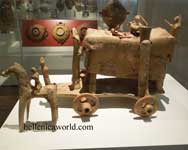
26747 : The carrying out of the body to the grave (ekphora)
[*]It must be remembered that the Greeks had no skilled embalmers at their service, and that they lived in a decidedly warm climate.
[+]See the well-known case of the wandering shade of Patrocius demanding the proper obsequies from Achilles (Iliad, XXIII. 71).
72. The Funeral Procession.--The day after the "laying-out" comes the actual funeral. Normally it is held as early as possible in the morning, before the rising of the sun. Perhaps while on the way to the Agora we have passed, well outside the city, such a mournful procession. The youngest and stoutest of the male relatives carry the litter: although if Lycophron's relatives had desired a really extravagant display they might have employed a mule car. Ahead of the bier march the screaming flute players, earning their fees by no melodious din. Then comes the litter itself with the corpse arrayed magnificently for the finalities, a honey cake set in the hands,[*] a flask of oil placed under the head. After this come streaming the relatives in irregular procession: the widow and the chief heir (her prospective second husband!) walking closest, and trying to appear as demonstrative as possible: nor (merely because the company is noisy and not stoical in its manner) need we deny that there is abundant genuine grief. All sorts of male acquaintances of the deceased bring up the rear, since it is good form to proclaim to wide Athens that Lycophon had hosts of friends.[+]
[*]The original idea of the honey cake was simply that it was a friendly present to the infernal gods; later came the conceit that it was a sop to fling to the dog Cerberus, who guarded the entrance to Hades.
[+]Women, unless they were over sixty years of age, were not allowed to join in funeral processions unless they were first cousins, or closer kin, of the deceased.
73. The Funeral Pyre.--So the procession moves through the still gloomy streets of the city,--doubtless needing torch bearers as well as flute players,--and out through some gate, until the line halts in an open field, or better, in a quiet and convenient garden. Here the great funeral pyre of choice dry fagots, intermixed with aromatic cedar, has been heaped. The bier is laid thereon. There are no strictly religious ceremonies. The company stands in a respectful circle, while the nearest male kinsman tosses a pine link upon the oil-soaked wood. A mighty blaze leaps up to heaven, sending its ruddy brightness against the sky now palely flushed with the bursting dawn. The flutists play in softer measures. As the fire rages a few of the relatives toss upon it pots of rare unguents; and while the flames die down, thrice the company shout their farewells, calling their departed friend by name--"Lycophron! Lycophron! Lycophron!"
So fierce is the flame it soon sinks into ashes. As soon as these are cool enough for safety (a process hastened by pouring on water or wine) the charred bones of the deceased are tenderly gathered up to be placed in a stately urn. The company, less formally now, returns to Athens, and that night there will probably be a great funeral feast at the house of the nearest relative, everybody eating and drinking to capacity "to do Lycophron full honor"; for it is he who is imagined as being now for the last time the host.
74. Honors to the memory of the Dead.--Religion seems to have very little place in the Athenian funeral: there are no priests present, no prayers, no religious hymns. But the dead man is now conceived as being, in a very humble and intangible way, a deity himself: his good will is worth propitiating; his memory is not to be forgotten. On the third, ninth, and thirtieth days after the funeral there are simple religious ceremonies with offerings of garlands, fruits, libations and the like, at the new tomb; and later at certain times in the year these will be repeated. The more enlightened will of course consider these merely graceful remembrances of a former friend; but there is a good deal of primitive ancestor worship even in civilized Athens.
BURNING is the usual method for the Greeks to dispose of their dead, but the burial of unburned bodies is not unknown to them. Probably, however, the rocky soil and the limited land space around Athens make regular cemeteries less convenient than elsewhere: still it would have been nothing exceptional if Lycophron had ordered in his will that he be put in a handsome pottery coffin to be placed in a burial ground pertaining to his family.
75. The Beautiful Funeral Monuments.--If the noisy funeral customs permitted to the Athenians may repel a later day observer, there can be only praise for the Athenian tombs, or rather the funeral monuments (stele) which might be set over the urns or ashes or the actual coffins. Nearly every Athenian family has a private field which it uses for sepulchral purposes: but running outside of the city, near the Itonian Gate along the road to the Peireus, the space to either side of the highway has been especially appropriated for this purpose. Waling hither along this "Street of the Tombs" we can make a careful survey of some of the most touching memorials of Athenian life. The period of hot, violent grief seems now over; the mourners have settled down in their dumb sense of loss. This spirit of calm, noble resignation is what is expressed upon these monuments. All is chaste, dignified, simple. There are no labored eulogies of the deceased; no frantic expressions of sorrow; no hint (let it be also said) of any hope of reunions in the Hereafter. Sometimes there is simply a plain marble slab or pillar marked with the name of the deceased; and with even the more elaborate monuments the effort often is to concentrate, into one simple scene, the best and worthiest that was connected with the dear departed. Here is the noble mother seated in quiet dignity extending her hand in farewell to her sad but steadfast husband, while her children linger wonderingly by; here is the athlete, the young man in his pride, depicted not in the moment of weakness and death, but scraping his glorious form with his strigil, after some victorious contest in the games; here is the mounted warrior, slain before Corinth whilst battling for his country, represented in the moment of overthrowing beneath his flying charger some despairing foe. We are made to feel that these Athenians were fair and beautiful in their lives, and that in their deaths they were not unworthy. And we marvel, and admire these monuments the more when we realize that they are not the work of master sculptors but of ordinary paid craftsmen. We turn away praising the city that could produce such noble sculpture and call it mere handicraft, and praising also the calm poise of soul, uncomforted by revealed religion, which could make these monuments common expressions of the bitterest, deepest, most vital emotions which can ever come to men.[*]
[*]As Von Falke (Greece and Rome, p. 141) well says of these monuments, "No skeleton, no scythe, no hour-glass is in them to bring a shudder to the beholder. As they [the departed] were in life, mother and daughter, husband and wife, parents and children, here they are represented together, sitting or standing, clasping each other's hands and looking at one another with love and sympathy as if it were their customary affectionate intercourse. What the stone perpetuates is the love and happiness they enjoyed together, while yet they rejoiced in life and the light of day."
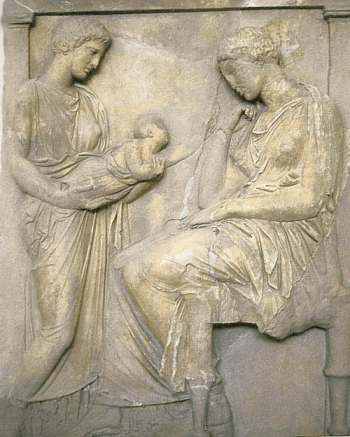
A Greek Stele (tombstone): A baby farewells his dead mother
See also Burial Rites, Ancient Greece
Epicurus: Why death is not a problem and other thoughts about death
Plato's Paradise and Hell, what happens after our death?
Interactive Lab: Fallen Heroes
Stelai
These tombstones were not made for or by distinguished people; they were made for everyday people by everyday workmen. We must treat them as gravestones, not as achievements of art. They were not made for competitive exhibition in this Museum. Nevertheless it is remarkable to what an extent technical ability had been developed, and that so many sculptors could be found in Greece capable of doing such excellent work. Some of them pass beyond the ordinary level, and exemplify the highest artistic skill. (http://www.oldandsold.com/articles21/greece-12.shtml)
Attic Grave Reliefs : The Hegeso, Dexileos and Ilissos Stelai
Grave stele with a family group, ca. 360 B.C. (Metropolitan Museum)
Quotations
According to the astrologers,
I Seleucus have few years
To live. But I don't care, for if
My way to Hell is rather brief,
It's the same way for us all.
I'll just pay death an earlier call.
Water-drinkers walk the course,
But wine-guzzlers take a horse.
Antipater of Sidon

An Angel (or Hermes Psychopompos ?) Source
Images
Amphora, c. 700 BC Athens, with men and women mourning
The Early Greek Concept of the Soul - Jan Bremmer, Princeton University Press; Reissue edition (October 1987)
Whatever Happened to the Soul? Scientific and Theological Portraits of Human Nature- Warren S. Brown, Nancey C. Murphy, H. Newton Malony (Eds.) Augsburg Fortress Publishers (October 1998) Modern Ideas of Theology, Philosophy and Natural Science about the Soul and Body (Is there a soul body duality, does a soul exist?)
G. Ahlberg, Prothesis and Ekphora in Greek Geometric Art, Göteborg 1971
R. S. J. Garland, Geras thanonton, Ancient Society 15/17 (1984/86) 5-22.
| Ancient Greece
Science, Technology , Medicine , Warfare, , Biographies , Life , Cities/Places/Maps , Arts , Literature , Philosophy ,Olympics, Mythology , History , Images Medieval Greece / Byzantine Empire Science, Technology, Arts, , Warfare , Literature, Biographies, Icons, History Modern Greece Cities, Islands, Regions, Fauna/Flora ,Biographies , History , Warfare, Science/Technology, Literature, Music , Arts , Film/Actors , Sport , Fashion --- |

